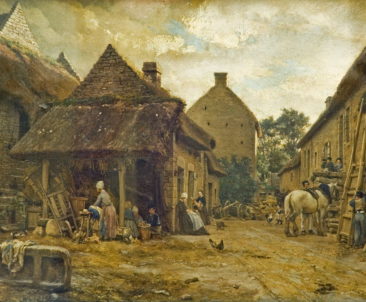
Gun Karl Fedorovich is a talented painter of historical, genre and portrait direction. Born in the family of the Baltic Germans in Sissegal in the Livonian Province, which was located on the shores of the Gulf of Riga in the Baltic Sea.
His father was a teacher of the parish school. Therefore, Karl received a general education at the Riga Cathedral School. And in 1850 he moved to St. Petersburg and enrolled as a draftsman to the lithographer Pappa. He also attended evening classes at the Academy of Fine Arts. Two years later Charles was accepted as a student of this academy. His main mentor was Professor PVBasin. During the academic course he received four silver medals for success in drawing and painting, and a small gold medal for the painting “Olympic Games” written in 1860.
In 1861, Gong received the title of class artist of the first article and a large gold medal for the program: “Grand Duchess Sofia Vytovtovna at the wedding of Basil the Dark.”
In 1863, the artist went abroad, as a pensioner of the Academy. Visiting Leipzig, Dresden, Prague and Munich, he settled in Paris and took up the picture: “The eve of the St. Bartholomew’s Night”, for which he subsequently received the title of academician. Living in Paris, Gong wrote many paintings, among which “Italian with flowers”, for which the author was awarded the title of professor.
In 1872, Gong moved to St. Petersburg, but lived there for long. In 1874, he had symptoms of pulmonary tuberculosis, and he went to other people to seek salvage from illness in a more favorable climate than St. Petersburg. However, the disease did not recede, and he died in Switzerland, in Davos.
Karl Gong is among the best painters of the Russian school. He possessed considerable observance, knew the pattern well, and had a strong and harmonious color. And his painting “Odalisque”, written in 1875, was sold at Christie’s auction for a record amount of 713747 US dollars.
In the Voronezh Regional Art Museum. I.N. Kramskoy presented the artist’s painting “Normandy”, written during his travels abroad in 1867.
Image: Gun Karl Fyodorovich. Normandy. 1867.
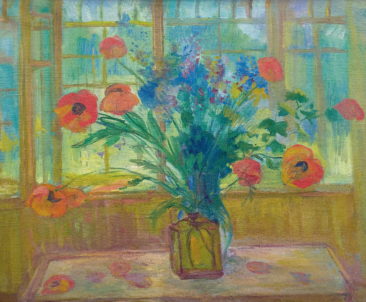
Pavel Varfolomeevich Kuznetsov is one of the most interesting painters of the first half of the 20th century.
He was born in Saratov in the family of an icon painter. When the artistic inclinations of the boy were clearly defined, he entered the “Painting and Drawing Studio” under the Saratov Society of Fine Arts Lovers.
The artist entered the Moscow School of Painting, Sculpture and Architecture in 1897. The study gave a circle of friends and like-minded people who later formed the artistic association “Blue Rose”.
Artistic gift was combined in Kuznetsov with inexhaustible energy of the soul, after all, expressed in the amazing creative longevity of a world-class master. He collaborated with editions of the Symbolist trend: magazines “Art”, “Golden Fleece”, and also was a member of the “World of Art”.
In 1904 Pavel Kuznetsov became one of the organizers of the exhibition “The Scarlet Rose”, and also took an active part in the formation of the artistic association “Blue Rose”. In 1906, the artist, at the invitation of Sergei Diaghilev, went to Paris, where he attended private art studios. His work took part in the exhibition of Russian art, according to which Kuznetsov was elected a member of the Autumn Salon. However, at the end of the 1900s the painter’s work was in crisis, repetitions began, and it seemed that the master had exhausted himself. But having undertaken trips to the Zavolzhsky steppes in 1911-1912 and Central Asia in 1912-1913, Kuznetsov’s work again skyrocketed, even higher than during the period of activity in the association “Blue Rose”. Also, the painter had the experience of a mentor. In the 1917-18’s. Kuznetsov taught at the Stroganov Art and Industrial School.
Everyone who knew Pavel Kuznetsov noted his amazing ability to always see the space of the picture as a whole. He often reinterpreted dreams and dreams that mingled with reality. Plane-linear rhythms, flickering coloring created an analogy with musical, literary symbolism. In the paintings of the so-called “steppe” or Kirghiz series the artist skillfully combined decorative generalization and a thin gradation of color shades. The master always inclined to monumentality and even tried to use in his easel paintings the technique of wall paintings, in particular seco. In his works there is poetry and dynamics, they are full of air and light. And although there is nothing defiant in them, they are very original, not ordinary. Immediately striking is the independence of color relationships, color, tone, etc.
In 1947, Kuznetsov returned to teaching at the Stroganov School, where he was appointed the head of the Department of Monumental Painting. In recent decades, he painted many landscapes, still lifes and portraits from nature. He especially loved the Baltic States.
“The definition of dark and light, the relationship of medium tones – as in music: tones, halftones, high notes, low. Canvas should live in a richness of inherent characteristics, visual attention … “said Pavel Kuznetsov to his students, and this was his artistic credo throughout his life.
A well-known painter died on February 21, 1968. In the Voronezh Regional Art Museum. I.N. Kramskoy presented his work “Still Life with Poppies.”
Image: P.V. Kuznetsov. Still life with poppies. 1940
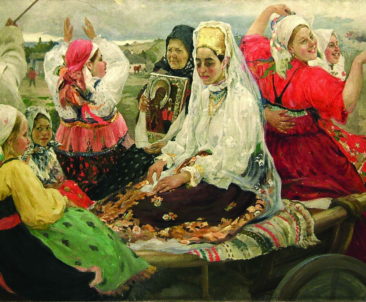
Alexander A. Buchkuri was born in the settlement Buturlinovka of the Voronezh province. A surname for the Russian ear he received from his father, a Greek of Turkish origin. However, from early childhood he lived in the house of his stepfather Michelson in the village of Khrenovskoye.
The interest and attraction of the boy to drawing in the family was supported, but he could not get education only at the age of 23, when a free drawing school opened in Voronezh.
Five years later, being an adult, Alexander Buchkuri decides to enter the Academy of Arts, and becomes a free-listening student of the studio IE. Repin.
Folk traditions have always interested Alexander Alekseevich. After studying at the Academy of Arts, Butchkuri did not stay in St. Petersburg, as one would expect, and in 1907 returned to his small homeland, Voronezh. Here he settled in Skoryazhny Lane, which now bears the name of the artist.
In Voronezh, Buchkuri not only actively wrote, but also engaged in teaching activities. He created a lot of wonderful, amazing and original works, developed his easily recognizable style.
The life of the artist and his wife was tragically cut short in 1942, when Voronezh was occupied by fascist troops. The family was shot, and the painter’s workshop was ruined.
In the collection of the Voronezh Regional Art Museum. I.N. Kramskoy there is a picture of Alexander Alekseevich Buchkuri “Wedding Train”. Colorful decorative folk costumes create an upbeat, joyful mood with their motley. The girlfriends of the bride are cheerful, the muzhik-driver is smiling cunningly, in the image of which the artist presented himself, not only the main heroine-the bride, who the girls sitting in front of her with surprise look at with surprise. The artist filled the major with a color scheme of sadness and psychology. Each image is filled with their own emotions and thoughts, and makes the viewer think.
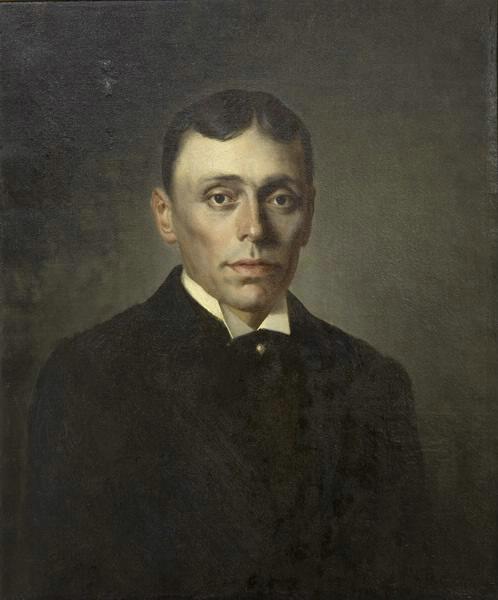
Shcherbatov Mikhail Lazarevich – a famous painter-portraitist, native of the village of Rudnya Bogucharskogo Uezd, (now Vorobievsky district). He studied
in the Voronezh workshop of the icon painter E.K. Ogneva. He also studied at the Drawing School of the Society for the Encouragement of Artists in St. Petersburg from 1867 to 1869. One year his teacher was Ivan Nikolaevich Kramskoy, and after Mikhail Lazarevich himself taught at the St. Petersburg Academy of Arts until 1878
The painter participated in the creation of a gallery of portraits of Russian historical figures commissioned by Vasily Andreyevich Dashkov for the Moscow Rumyantsev Museum. For 15 years I.N. Kramskoy and M.L. Shcherbatov worked in the same workshop. The main part of the artist’s creative heritage was portraiture, which is now stored in the State Hermitage Museum, the State Historical Museum, the State Russian Museum, the Voronezh Regional Art Museum. I.N. Kramsky and others. In the years 1907-1910. Mikhail Lazarevich Scherbatov gave a number of his works as a gift to the Ostrogozhsk art gallery. And in Rudna, in 1912, a school building for peasant children was built on his means.
Mikhail Scherbatov executed many orders for the royal court. In the Voronezh Regional Art Museum. The portrait of Elena Pavlovna Kochubei is presented by I. N. Kramskoy. The Princess occupied a prominent position at court: the maid of honor, the state lady of the court of Empress Maria Feodorovna, the chief of the Imperial Court of the Russian Empire, the Ober-Hofmeister. According to memoirs, she dominated court life, she was an invariable participant in palace festivities and entertainments. Portraits of the princess, famous for its beauty, were painted by many artists. In the portrait of Helen Pavlovna brush Michael Scherbatov see her self-confidence, strictness and exactingness. But, despite the fact that the work was done already at the end of her life, the face of an elderly woman left a trace of her former beauty.
The painter lived a long and rich life, remained in the memory of people as a talented painter.
Mikhail Lazarevich Scherbatov died on December 12, 1924.
Image: M. L. Shcherbatov. Portrait of E. P. Kochubey. 1888

October 19 in the Voronezh Regional Youth Library named after V.M. Kubanev opened an exhibition within the project “Works of Russian emigre artists in provincial Russian museums.”
The exhibition is organized by the Information and Cultural Center “Russian Abroad”, Voronezh Regional Art Museum. I.N. Kramskoy, the Faculty of Arts of the VSPU, the Voronezh Regional Youth Library. V.M. Kubanev.
The exposition includes high-quality printed copies of works by Russian artists from abroad, from the VOKHM Foundation. I.N. Kramskoy. The exposition presents works of emigre artists, whose names are well known and are the pride of Russian culture – Alb. Benois, K. Somov, M. Dobuzhinsky, N. Roerich, P. Nilus, as well as artists whose work is familiar only to specialists – E. Kiseleva, P. Shmarov.
The exhibition will last until the end of November 2017.

October 10 at 15.00 in the Center for military-patriotic education “Museum-diorama” an exhibition of computer copies of engravings of the Peter the Great from the collection of the VOKH them. I.N. Kramskoy.
Students of the Voronezh Aviation Technical School named after V.P. Chkalov. The children got acquainted with the exhibition works and watched the film “Voronezh – the cradle of the navy”.
The exhibition will work on October 24, 2017.
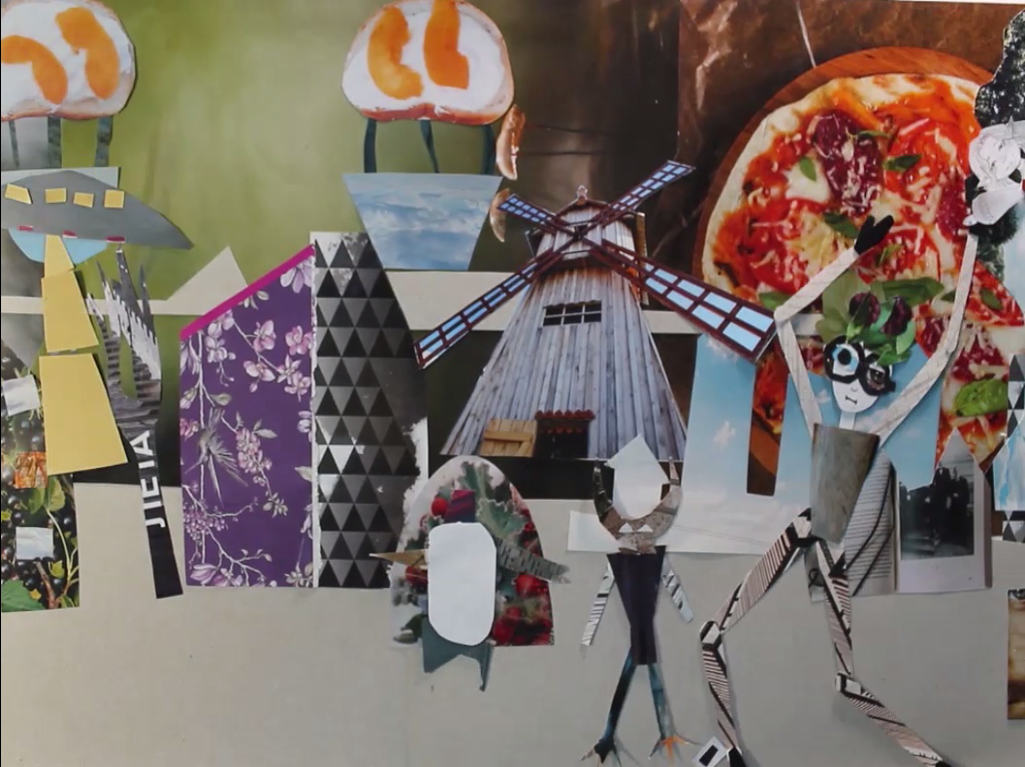
Dear friends!
As part of the “Night of the Arts” museum, on November 4, a family animation workshop took place, where children together with their parents took part in the creation of the animated film City of Arts. The participants, led by Olesya Skorobogatova, teacher of the “Telescope” screen creativity studio, built an original urban space in collage technology and revived interesting stories in this city.
Enjoy watching!

November 23, 2017 in the VOKHM them. I.N. Kramskoy for the first time held an open master class on silk screen printing for adults and children from 7 years. The master-class was conducted by the Moscow artist-graphic artist Boris Belsky.
The artist told about the features of the silkscreen technique and showed how the works of visual art are created using screen printing. All participants of the master class were able to try their hand at creating a drawing in the technique of silk screen printing.
The master class was supported by the portal about the art of Umbra Media.
Silkscreen or screen printing until about the middle of the 1950s was used mainly for industrial purposes. But then more and more artists began to come to her to create works of visual art. With serigraphy worked Andy Warhol, Marcel Duchamp, Robert Rauschenberg and others.
Reference:
Boris Belsky – a famous artist, graphic artist, academician of the Russian Academy of Arts. He was born in Moscow in 1960. Graduated from the Moscow State Academic Art Institute. IN AND. Surikov. A participant of more than 120 exhibitions in Russia and abroad. Boris Belsky worked in the printed graphic workshops of the Franz Mazerel School in Belgium, the “Print Studio” in Glasgow (Scotland), the graphic faculty of the University of Radgers in New Jersey (USA), the Corcoran School in Washington (USA). His works are in museums and private collections in Russia, Belarus, Belgium, Great Britain and the USA.
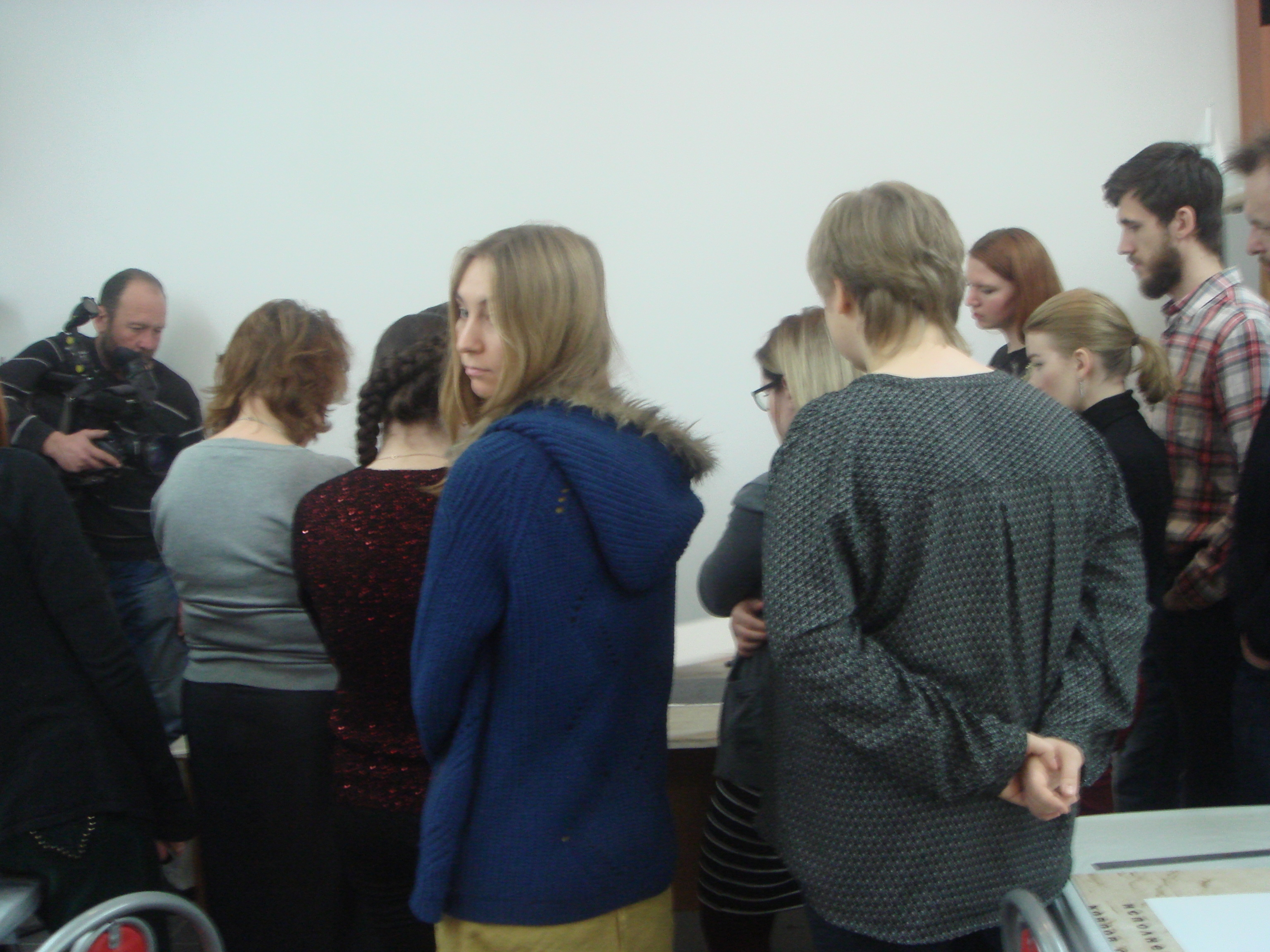
November 19 at the VOKHM them. I.N. Kramskoy hosted a master class from the series “Spot and line. Graphic techniques and techniques “(for professionals and amateurs).
In connection with a large number of participants, Denis Bulavintsev conducted a master class called “Simple Geometry” for two groups: at 11.00. and at 14.30.
All participants approached the task very creatively and with great imagination, resulting in wonderful works created from the simplest geometric figures – squares, triangles, rhombuses and circles.
The next master class for this audience will be held on December 17 at 11.00 clock. The lesson titled “Collage”, will acquaint you with the peculiarities of work in the same technique.
Entry to the lesson by phone: 255-50-81.
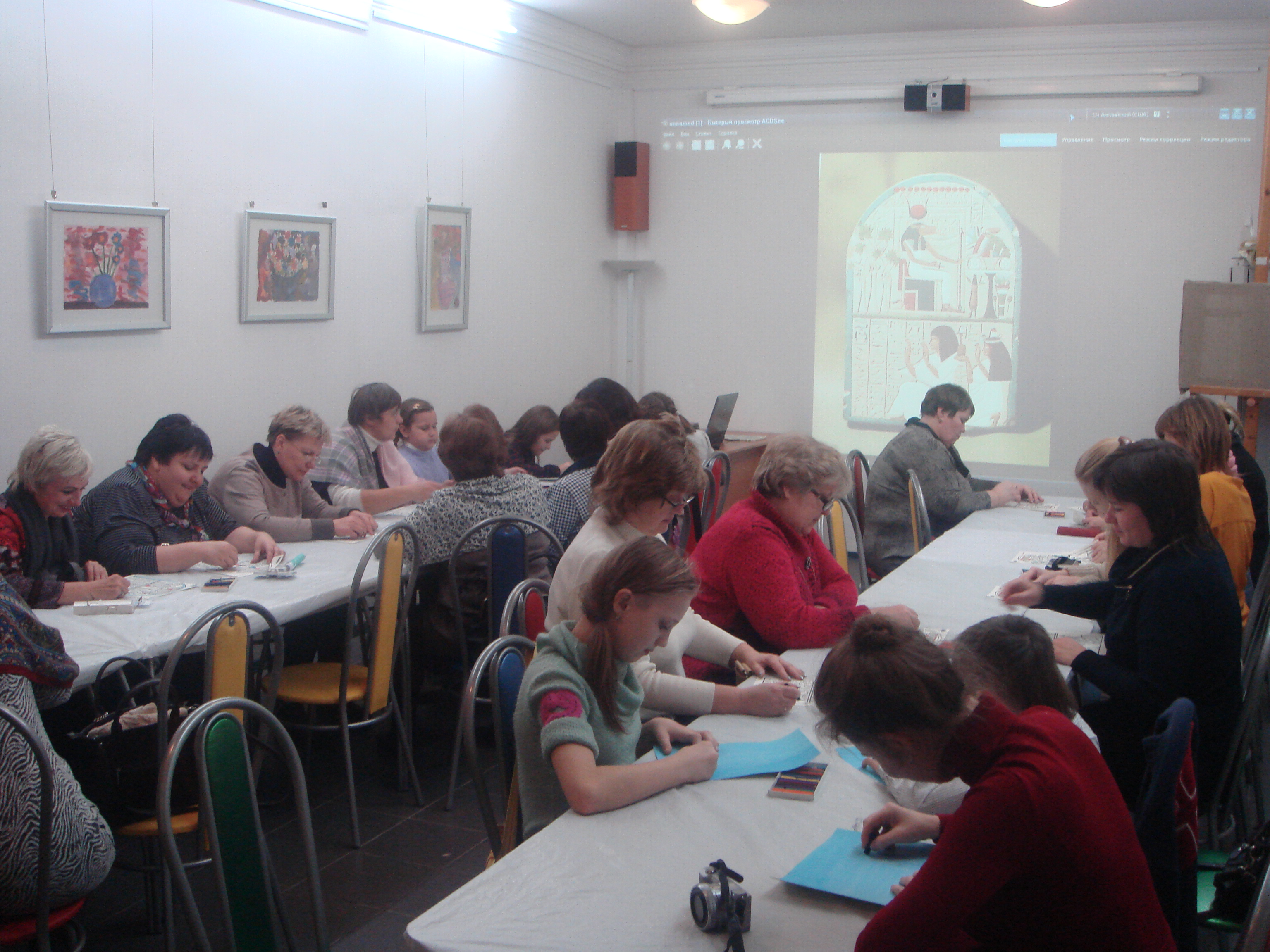
November 11, 2017 for a tourist group from the city of Lipetsk was held a museum lesson, acquainted participants with the features of work in the technique of oil pastels (on the example of works by Pablo Picasso, performed in this technique). In addition, the participants got acquainted with one of the most interesting exhibits of the museum – the ancient Egyptian stela, represented in the museum’s exposition. We learned about the history of the monument, its purpose, that in due course the polychrome painting, which once covered the masterpiece, was practically lost. During the practical part, all present could work in the technique of oil pastel and with its help paint the image of the stele. Participants could take as a basis the image of the reconstruction of the stele, executed by Voronezh artists, or paint the stele in any other color scheme.